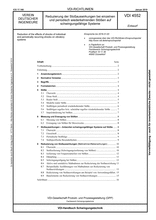Standards Worldwide
Standards Worldwide
Phone +49 30 58885700-07

Draft technical rule
VDI 4552:2019-01 - Draft
Reduction of the effects of shocks of individual and periodically recurring shocks on vibratory systems
- German title
- Reduzierung der Stoßauswirkungen bei einzelnen und periodisch wiederkehrenden Stößen auf schwingungsfähige Systeme
- Publication date
- 2019-01
- Original language
- German
- Pages
- 16
- Publication date
- 2019-01
- Original language
- German
- Pages
- 16
Product information on this site:
Quick delivery via download or delivery service
Buy securely with a credit card or pay upon receipt of invoice
All transactions are encrypted
Short description
In contrast to a harmonic vibration excitation, a frequency consideration for the assessment of the impact response is not enough. A consideration of vibration excitation and response in the time domain is also required because the maximum values of the vibrations can not be determined from the frequency spectrum. In the case of bursts of decaying single impacts, the method of classical vibration isolation (pure harmonic excitement, pure single momentum excitement) is often not sufficient and their careless application in some cases even leads to the opposite effect, namely a vibration amplification. Such cases require careful consideration of the potential side effect of classical vibration isolation and are described in this standard. It gives an overview and also discusses the measurement and generation of shocks as well as the effects (responses of oscillatory systems to collisions). Furthermore, exemplary embodiments of measures to reduce shock effects and applications are described.
Content
ICS
17.160
Also available in
Loading recommended items...
Loading recommended items...
Loading recommended items...
